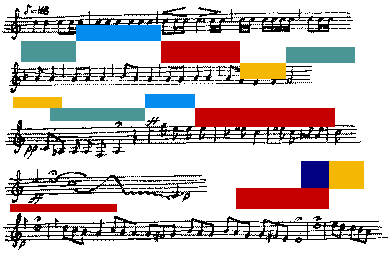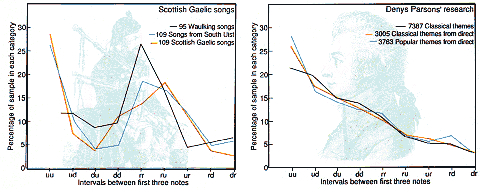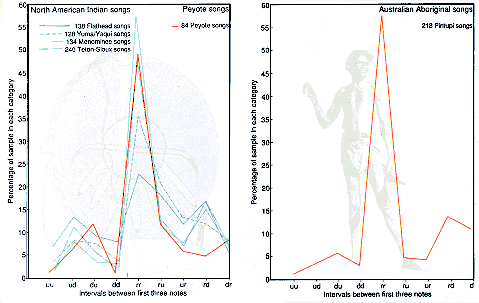 |
Geography and human song
|
 |
In the West, a tune often begins with a rising lilt. But music in other parts of the world seems to follow a different pattern. What might this tell us about our musical perceptions?
Graham Pont
MUSICOLOGISTS have long struggled to find underlying structures
in human music. The ancient Greeks dreamt of a rigorous mathematical science
of melody that would emphasise the rationality of human culture, and also
reveal its diversity. Sadly, progress towards this ideal has been slow. But
in 1975, Denys Parsons, a scientist then at the British Library, achieved
a significant breakthrough. He devised a way of describing a melody simply
by its "pitch profile"-the pattern formed by the sequence of steps between
each note in turn. Our research, building on Parsons' work, suggests that
this pattern can distinguish forms of music from different cultures.
Parsons' Directory of Tunes and Musical Themes contains the pitch
profiles, recorded as "up" (a rise in pitch), "down" (a descent in pitch)
or "repeat" (no change in pitch), of more than 10 000 classical themes and
nearly 4000 popular tunes. He then grouped those melodies with common profiles,
enabling a reader to find quickly the title, composer or source of the particular
tune in mind.
His classification revealed something unexpected. In a sample of more than
7000 classical themes, he found an intriguing pattern: in the melodies in
his sample, the most common initial profile is "up-up' '-that is, the preferred
pitch profile is a rising interval from the first to the second note, and
from the second note to the third. The next most popular is "up-down"; the
least popular is "down-repeat". Parsons enlarged his sample to include a
further 3005 classical melodies and 3763 popular songs. For each sample he
ranked the nine possible pitch profiles, for the first three notes, in order
of frequency. With the opening note marked with an asterisk, the order was:
*UU, *UD, *DU, *DD, *RR, *RU, *UR, *RD, *DR
Parsons announced his discovery in the New Scientist
on 24 March 1977, and wondered what musicologists would make of it. Until
recently, the answer would have been "very little". Although his directory
has received some measure of acceptance, no one has seriously responded to
the issues he raised. My colleagues and I at the University of New South
Wales have accepted the challenge, and have come up with some interesting
results.
We first verified his findings on a much larger sample of Handel's work.
Our analysis shows the marked preference for "up" at the first interval,
between the first and second notes of Handel's melodies. It also seems to
suggest the lack of any marked preferences for either "up" or "down" thereafter,
although both are consistently preferred to "repeat". We analysed Parsons'
sample of the works of other major composers, such as
Mozart and Beethoven, with similar results.
Yet while these studies confirm Parsons' original observations, there appears
to be a good deal of personal variation in the preferences of different
composers. This suggests the possibility of using this approach to identify
and quantify precise characteristics in a composer's own melodic
preferences-something which Parsons has begun to explore. Science might then
at last obtain an objective measure of what the ancient Greek theorists called
"ethos"-the social or individual character recognised in typical patterns
of pitch or
rhythm.
In its present form at least, Parsons' law holds mainly for the first, and
sometimes the second, intervals of European melody. The initial direction
of the melody, the step from the first note to the second, is statistically
the most significant. Parsons has recently found that his test, if extended
to the third interval, also reveals a marked preference or the "up" profiles,
particularly *UUU, but other workers have yet to confirm the generality of
this finding.
Even so, his original discovery is intriguing. Why the marked significance
of the first note in a melody? My colleague, Jenny Nevile, has suggested
that it may be connected with the way we perceive sounds.
Musicologists have long known that if you
remove the initial articulation of a vocal or instrumental, so that listener
hears only the after-sound, they find it very difficult, sometimes impossible,
to distinguish one voice or instrument from another. In other words, the
recognisable timbre of different voices and instruments
is mainly conveyed in the initial speaking, the opening of the sounds. I
suspect that both Parsons' finding and this aural significance of the first
note are part of the same phenomenon: the role of the initial sounding, in
the direction of its pitch as well as timbre, in enabling us to identify
a tune.
Stimulated by these speculations, we wondered whether Parsons' law held across
history, and across cultures. It could be applied to the most primitive form
of musical notation developed in modern Europe-the neumes. These signs arose
late in the first millennium, as an aide-mémoire for the singing
of liturgical chants. The neumes record only the general direction of a melody,
but this is the very feature needed for Parsons' test. Our analysis of the
sacred chants in a modern collection, the Liber Usualis, provides
dramatic confirmation of Parsons' law (see Figure 1). For the first two intervals
of the chant, the frequency of "up-up" is almost as high as that for modern
melody. This suggests that Parsons' test has revealed not merely an accidental
feature of modern melody, but a fundamental tendency of European intonation.
We think that this is one of the most important discoveries ever made in
the science of melody.
 |
| Figure 1 Ancient Greek musicians, medieval monks and Baroque composers all tended to start their melodies with two rising intervals. Parsons' test seems to have revealed a fundamental preference in the intonation of Western music. |
We tried to confirm this finding by looking at 29 melodies
preserved in ancient Greek notation-but this sadly limited sample is too
small to provide statistically significant data. Yet from what we have, it
looks as though the melodies of the ancient Greeks have more in common with
medieval chant than they do with modern melody. Further research might shed
some light on the much debated origin of Christian chant. The prevailing
view today is that Christian chant is largely Jewish in origin, rather than
Greek. But would scholars revise their opinions if it were discovered that
the oldest examples of traditional or pre-Christian Jewish chant do not share
the preferred pitch profile of "up-up"?
Parsons' research raised other important issues: the relationship of Western
music with the music of other cultures, and even the origins of human music
in the natural world. The further we move from the artificial world of
modern musical notation, the nearer we approach
the music of nature
in which it is often impossible to say where exactly a melody begins
or ends, or whether it is moving in discernible "intervals" or even if
a cry or vocalisation is a melody at all. Parsons' test might not fit
all such situations, but we can validly apply it to the songs of birds that
sing in clearly defined intervals, such as the cuckoo with its insistent
"up-down" call.
We have begun to explore the universality of Parsons' law in human cultures,
by studying the melodies of non-European cultures, or those of western
subcultures that have retained some independence from the mainstream. We
find that Parsons' test does reveal profound differences. Take, for example,
the preferred pitch profiles of Scottish Gaelic songs, derived from three
collections made at different times by three independent researchers (see
Figure 2). Two of these collections show the marked European preference for
the initial rising contour, but the distribution of frequencies for other
intervals is radically different from Parsons' European norm (see Figure
3). Similarly, an extensive and reliable collection of Romanian folk music
yields an exceptionally high level of the initial rising profile, together
with a marked preference for the profiles such as "repeat-up" and
"up-repeat" which are very low in Parsons' European scale.
 |
| Rebellious Scots: Gaelic songs (left,Figure 2) tend to deviate from the classical European norm (right,Figure 3)mapped by Parsons. |
We need one final test to demonstrate the reliability of Parsons'
law: can his test produce non-European pitch profiles which are consistently
different from the European norm? Without this test, it might be possible
to argue that Parsons' findings are culture-dependent-like some
intelligence tests that might be
reliable for the society that invented them
but unreliable for other social groups.
We chose to compare the pitch profiles of the songs collected by Frances
Densmore from the remnants of four North American Indian tribes, during the
first third of this century. From her observations we derived Figure 4; which
leaves no doubt that Parsons' test can meet this final criterion of a general
comparative method. it reveals that the traditional melodies in this part
of the world favoured initial pitch contours radically different from those
that have prevailed in Europe. The initial contour of "up-up" is one of the
least common in American Indian songs, whereas the pattern of
"repeat-repeat"-fifth in the European list of preference is far and away
the most preferred, being found in almost two thirds of the Menominee songs.
A similar pattern of preferences emerges from a recent collection of 84 Peyote
songs, melodies coming not from a tribal society but a
religious cult
that has developed among various surviving groups of North American Indians.
Our evidence suggests that the singers of this new cult preserve the
characteristic melodic contour of their tribal ancestors.
Songs of the Australian Aborigines show an even higher level of the
"repeat-repeat" contour in our analysis of 218 songs of the Pintupi of central
Australia (see Figure 5). But what is the true significance of these comparisons?
Are they reliable indices of genuine cultural differences?
 |
| Hear the difference: American Indians (left, Figure 4) and Australian Aborigines (right, Figure 5) favour "repeat-repeat" intervals |
To be sure, researchers will need to evaluate Parsons' test
further, and possibly introduce some refinements. But his discovery suggests
many exciting possibilities. It could provide a simple way of plotting the
distribution of "horizontal" melodies, those with a more or less stable pitch,
popular among the native people of North America, Australia and elsewhere-as
shown, for example, by fragments from an ancient song of Hawaii and one in
the Babylonian liturgy.
These are quite different from another archaic and widespread kind, which
the late Curt Sachs called, in his book The Wellsprings of Music,
"tumbling strains". This sort of singing takes the form of a leap to a high
note followed by descent to a lower level. The examples that follow are from
music by the Zuni of New.Mexico, Australian Aborigines, and the Watusi of
Africa.
Parsons' data show no significant preference for either form in the beginnings
of European melodies, but the preponderance of horizontal tunes is strongly
marked in the music of North American Indians, and some Hispanic, Celtic
and Gaelic songs. The non-Gaelic songs of Britain show the reverse situation,
with the "down-down" more common that "repeat-repeat". This could be a
significant discriminator in ethno-musicological and bioacoustic classification
For instance, in two small samples of Irish songs,
the "repeat-repeat" profile was the one most preferred by Gaelic Irish singers,
but was among the least preferred by Anglo-Irish singers. In the classical
music of Japan and Korea, the most common pitch profile seems to be "up-down",
a preference we have not yet found anywhere else. So the comparative study
of pitch profiles could provide a way of mapping the geography of human song,
and perhaps the song of other animals too.